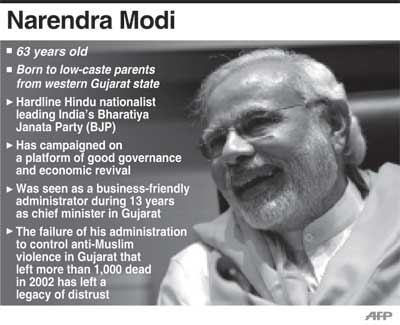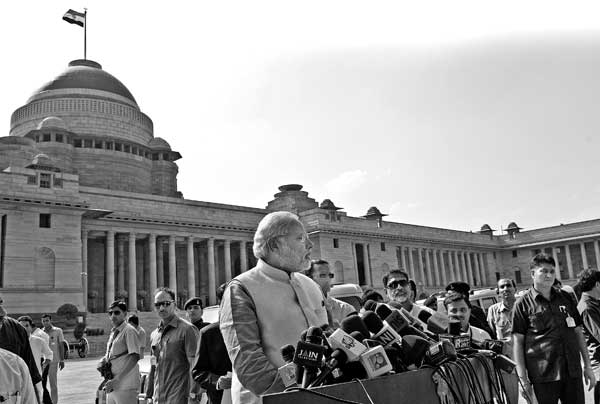Reply To:
Name - Reply Comment
Last Updated : 2024-04-27 00:40:00
.jpg) India’s prime minister-elect Narendra Modi is a conundrum. So it seems for the time being. From his alleged role in the massacre of Muslims in the 2001 Gujarat communal riots to his invitation to Pakistan’s Prime Minister Nawaz Shariff to attend his inauguration on Monday, analysts search for answers. How will he drive the economy? What will be his foreign policy? Will India’s Muslims be safe?
India’s prime minister-elect Narendra Modi is a conundrum. So it seems for the time being. From his alleged role in the massacre of Muslims in the 2001 Gujarat communal riots to his invitation to Pakistan’s Prime Minister Nawaz Shariff to attend his inauguration on Monday, analysts search for answers. How will he drive the economy? What will be his foreign policy? Will India’s Muslims be safe?.jpg) It is unlikely that Modi will be another I.K. Gujral who during his premiership pursued a policy of appeasing India’s neighbours. His party has expressed concerns over inroads China is making in the region while Modi is seen as an uncompromising hardliner on national security issues. It is in this light that Modi’s invitation to South Asian leaders including Sri Lanka’s President Mahinda Rajapaksa and Pakistan’s Prime Minister Nawaz Sharif to attend his inauguration on Monday assumes political significance
It is unlikely that Modi will be another I.K. Gujral who during his premiership pursued a policy of appeasing India’s neighbours. His party has expressed concerns over inroads China is making in the region while Modi is seen as an uncompromising hardliner on national security issues. It is in this light that Modi’s invitation to South Asian leaders including Sri Lanka’s President Mahinda Rajapaksa and Pakistan’s Prime Minister Nawaz Sharif to attend his inauguration on Monday assumes political significance Modi’s BJP-led National Democratic Alliance (NDA) coalition together with allies such as such as Tamil Nadu Chief Minister Jayaram Jaylalithaa’s All India Anna Dravida Munnetra Kazhakam enjoys a two thirds majority in parliament, but there is little space in today’s democratic India for any constitutional coup to undermine democracy. The NDA won some 38 per cent of the total popular vote. Yet its MPs will comprise more than 60 per cent of the next Parliament. This anomaly is a major defect in the first-past-the-post electoral system. The last time a single party won a huge majority was in 1984, when Rajiv Gandhi and his Congress Party were swept to power on a wave of sympathy following the assassination of Indira Gandhi. The 400 plus seats the Congress and its allies had in the 530 plus seat Lok Sabha enabled the then Rajiv Gandhi government to wield the stick to command compliance from neighbouring countries such as Nepal and Sri Lanka, but at the same time it acted realistically in the greater interest of India.
Modi’s BJP-led National Democratic Alliance (NDA) coalition together with allies such as such as Tamil Nadu Chief Minister Jayaram Jaylalithaa’s All India Anna Dravida Munnetra Kazhakam enjoys a two thirds majority in parliament, but there is little space in today’s democratic India for any constitutional coup to undermine democracy. The NDA won some 38 per cent of the total popular vote. Yet its MPs will comprise more than 60 per cent of the next Parliament. This anomaly is a major defect in the first-past-the-post electoral system. The last time a single party won a huge majority was in 1984, when Rajiv Gandhi and his Congress Party were swept to power on a wave of sympathy following the assassination of Indira Gandhi. The 400 plus seats the Congress and its allies had in the 530 plus seat Lok Sabha enabled the then Rajiv Gandhi government to wield the stick to command compliance from neighbouring countries such as Nepal and Sri Lanka, but at the same time it acted realistically in the greater interest of India.
.jpg) It is the Corporate India together with India’s Corporate Media that created the Modi brand. How they made use of the strategies and tools of the marketing world and ruthlessly promoted Modi and branded him as India’s hope should become an essential lesson for marketing students.
It is the Corporate India together with India’s Corporate Media that created the Modi brand. How they made use of the strategies and tools of the marketing world and ruthlessly promoted Modi and branded him as India’s hope should become an essential lesson for marketing students. 
Add comment
Comments will be edited (grammar, spelling and slang) and authorized at the discretion of Daily Mirror online. The website also has the right not to publish selected comments.
Reply To:
Name - Reply Comment
US authorities are currently reviewing the manifest of every cargo aboard MV
On March 26, a couple arriving from Thailand was arrested with 88 live animal
According to villagers from Naula-Moragolla out of 105 families 80 can afford
Is the situation in Sri Lanka so grim that locals harbour hope that they coul

9 hours ago
26 Apr 2024